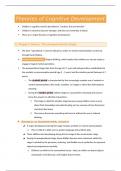Summary
Summary Chapter 4 SLK 210- Early childhood Development
- Course
- Institution
- Book
This chapter summary includes a detailed review of the prescribed textbook of the University Of Pretoria in SLK 210. This summary includes all sections of the chapter that were within the demarcation for semester test 1 (2024)
[Show more]




